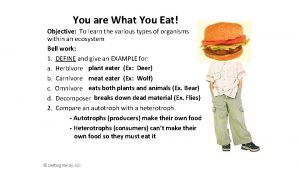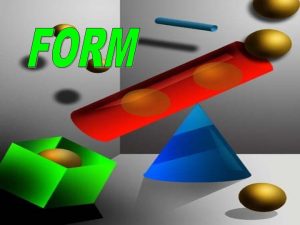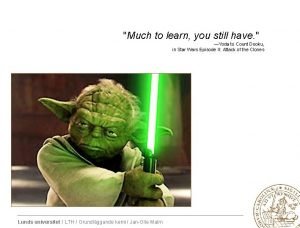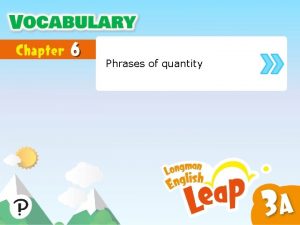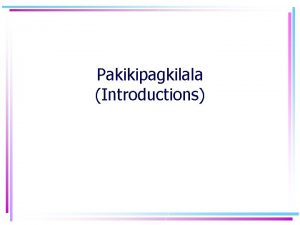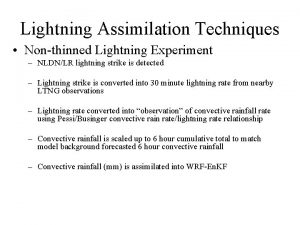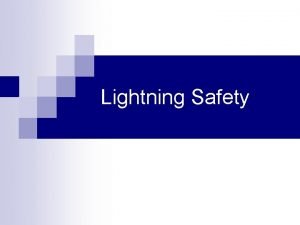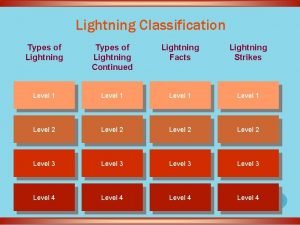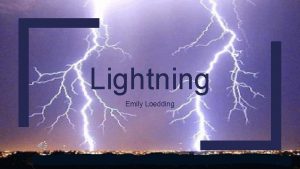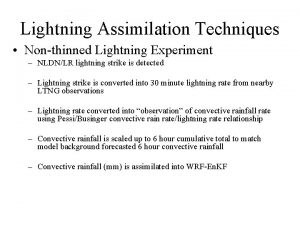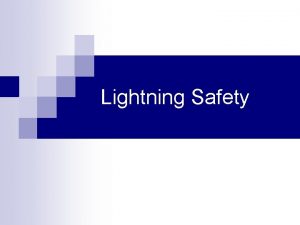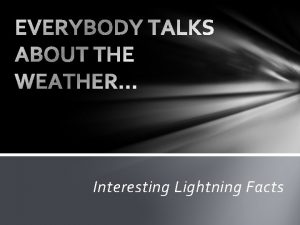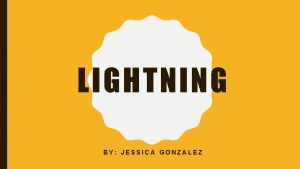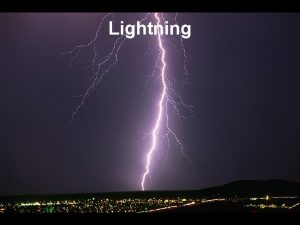You will learn How lightning forms Welcome to




















- Slides: 20

You will learn: How lightning forms Welcome to my world!

Weather Patterns 2 Blizzards • The National Weather Service classifies a winter storm as a blizzard if: • The winds are 56 km/h. • The temperature is low. • The visibility is less than 400 m in falling or blowing snow. • These conditions persist for three hours or more.

Here’s theory. What happens in real life?


Weather Patterns Severe Weather—Thunderstorms • Thunderstorms occur in warm, moist air masses and along fronts. • Warm, moist air can be forced upward where it cools and condensation occurs, forming cumulonimbus clouds that can reach heights of 18 km.

Weather Patterns 2 Lightning and Thunder • Thunder results from the rapid heating of air around a bolt of lightning, which can reach temperatures of about 30, 000°C. • This extreme heat causes air around the lightning to expand rapidly. Then it cools quickly and contracts. • The rapid movement of the molecules forms sound waves heard as thunder. Chapter menu Resources Copyright © by Holt, Rinehart and Winston. All rights reserved.

Weather Patterns 2 Lightning and Thunder • Inside a storm cloud, warm air is lifted rapidly as cooler air sinks. This movement of air can cause different parts of a cloud to become oppositely charged. Chapter menu Resources Copyright © by Holt, Rinehart and Winston. All rights reserved.

Chapter 3 Section 3 Severe Weather Tornadoes • A tornado is a small, spinning column of air that has high wind speeds and low central pressure and that touches the ground. • A tornado starts out as a funnel cloud that pokes through the bottom of a cumulonimbus cloud and hangs in the air. The funnel cloud becomes a tornado when it makes contact with Earth’s surface. Chapter menu Resources Copyright © by Holt, Rinehart and Winston. All rights reserved.

Weather Patterns 2 Tornadoes • A tornado is a violently rotating column of air in contact with the ground. • In severe thunderstorms, wind at different heights blows in different directions and at different speeds. • This difference in wind speed and direction, called wind shear, creates a rotating column parallel to the ground. Chapter menu Resources Copyright © by Holt, Rinehart and Winston. All rights reserved.

Weather Patterns 2 Tornadoes • A thunderstorm’s updraft can tilt the rotating column upward into the thunderstorm creating a funnel cloud. • If the funnel comes into contact with Earth’s surface, it is called a tornado. Chapter menu Resources Copyright © by Holt, Rinehart and Winston. All rights reserved.

Weather Patterns 2 Tornadoes • A tornado’s destructive winds can rip apart buildings and uproot trees. Chapter menu Resources Copyright © by Holt, Rinehart and Winston. All rights reserved.

Weather Patterns 2 Tornadoes • The updraft in the center of a powerful tornado can lift animals, cars, and even houses into the air. • Although tornadoes rarely exceed 200 m in diameter and usually last only a few minutes, they often are extremely destructive. However, tornadoes are not the most destructive severe weather due to the small scope of the storm. Chapter menu Resources Copyright © by Holt, Rinehart and Winston. All rights reserved.

Chapter menu Resources Copyright © by Holt, Rinehart and Winston. All rights reserved.

Chapter 3 Section 3 Severe Weather Hurricanes • How a Hurricane Forms A hurricane begins as a group of thunderstorms moving over tropical ocean waters. Winds traveling in two different directions meet and cause the storm to spin. • Damage Caused by Hurricanes are the most damaging severe weather. Damage is caused by high winds (wind speeds of most hurricanes range from 120 to 150 km/h) and torrential rain. Chapter menu Resources Copyright © by Holt, Rinehart and Winston. All rights reserved.

Chapter menu Resources Copyright © by Holt, Rinehart and Winston. All rights reserved.

Weather Patterns 2 Hurricanes • It is like a machine that turns heat energy from the ocean into wind. • A storm must have winds of at least 119 km/h to be called a hurricane. • Similar storms are called typhoons in the Pacific Ocean and cyclones in the Indian Ocean. Chapter menu Resources Copyright © by Holt, Rinehart and Winston. All rights reserved.

Composite image of 2010 hurricanes. 20 degrees N 5 degrees N Chapter menu Resources Copyright © by Holt, Rinehart and Winston. All rights reserved.

Hurricane Camille, August 1969. Highest wind speed: 190 m. p. h. Chapter menu Resources Copyright © by Holt, Rinehart and Winston. All rights reserved.

Richelieu Apartments Before Hurricane Camille Mary Ann Gerlach claimed she attended a Hurricane Party on the third floor. Pass Christian, Mississippi Chapter menu Resources Copyright © by Holt, Rinehart and Winston. All rights reserved.

Richelieu Apartments After Hurricane Camille Mary Ann Gerlach survived and lived to tell the story. Chapter menu Resources Copyright © by Holt, Rinehart and Winston. All rights reserved.
 Kinesthetic learners definition
Kinesthetic learners definition The more you study the more you learn
The more you study the more you learn Man lernt solange man lebt
Man lernt solange man lebt You are what you learn
You are what you learn Wise men three clever are we
Wise men three clever are we Why are related forms more agreeable than unrelated forms?
Why are related forms more agreeable than unrelated forms? Am not contracted form
Am not contracted form Why are related forms more agreeable than unrelated forms
Why are related forms more agreeable than unrelated forms Why are related forms more agreeable than unrelated forms?
Why are related forms more agreeable than unrelated forms? Strong forms and weak forms
Strong forms and weak forms Tiosulfat titrering
Tiosulfat titrering Extension work activities
Extension work activities What do we learn from ants
What do we learn from ants Obey the teacher
Obey the teacher Would you rather learn english or french passive voice
Would you rather learn english or french passive voice Tell me and i forget teach me and i remember
Tell me and i forget teach me and i remember What do you expect to learn
What do you expect to learn Quantity expression
Quantity expression Pakikipagkilala
Pakikipagkilala Presen tsimple
Presen tsimple You say that you love rain
You say that you love rain



